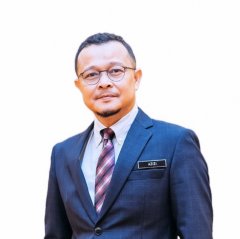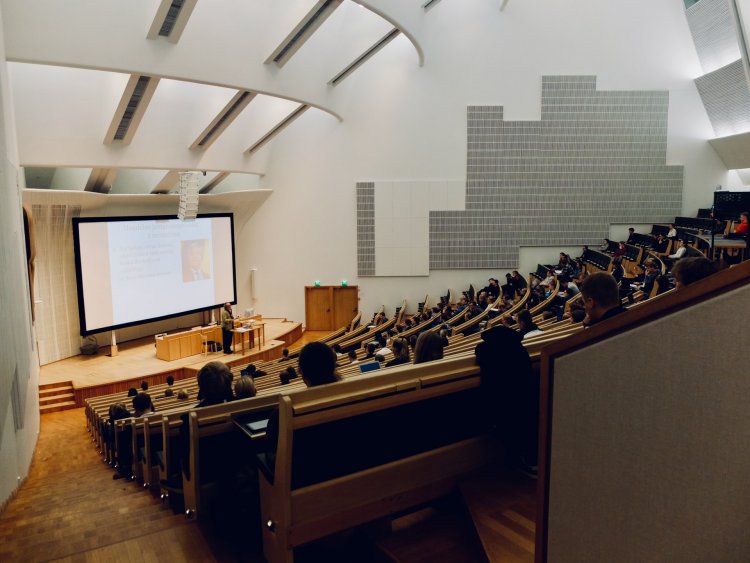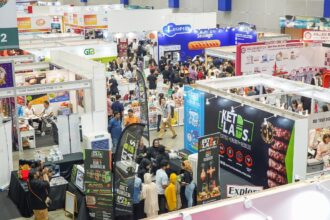By Dr. Noor Azizi Ismail and Dr. Adams Adeiza
About two years ago, I was invited to be one of the panellists to discuss a very interesting topic: Marriage of the Intelligence: Intelligent Factories and Intelligent People – Do We Need Both? The event was hosted by the Malaysian Technology Development Corporation. Since I was the only academician on the panel, the questions posed to me were more related to talent development and university-industry partnerships in preparing future-proof graduates.
Charles Schwab coined the term IR4.0 during World Economic Forum in 2015, and since then, the term has become a buzzword. Almost everyone is talking about the marriage of physical, digital and biological spheres that have and will change the way we live, work and behave. During the panel discussion, I reasoned that while it is interesting to talk about the future, is important to properly diagnose our present realities and challenges, as that understanding would permit better ideation and development of solutions. So, to help me generate insights to address the theme of the discussion, I posed questions like: Where are we compared to those technologically advanced countries with regards to talent development, the sophistication of technology adoption and development, and their success? Do current policies and initiatives support our vision and mission in a coherent manner? I recently reflected on my responses during the panel and this article answers the questions I had asked.
The Vision
In 2019, former Prime Minister Tun Dr Mahathir Mohamad launched a new vision for Malaysia to become an entrepreneurial nation by 2030, a significant shift from the trading nation we are now. Implied in the vision is the need for Malaysia to become an innovative country, one that is strongly backed by Science and Technology-based Innovation. In 2020, the Academy of Sciences Malaysia launched Malaysia Science, Technology, Innovation and Economy (MYSTIE) Framework. The framework provides a systematic approach to transforming Malaysia into a knowledge-intensive economy by design. It aims to generate shared economic prosperity across the diverse ecosystems in the country and move Malaysia up in the global innovation value chain. Although it is still in the early phase to see the results of the initiatives, it suffices to do a quick analysis of where things stand now.
Then and Now
Fifteen years ago, I was a certified Business Intelligence trainer with a leading tech company. As of then, BI was the buzzword much like Big Data, Cloud Computing, Artificial Intelligence and the Internet of Things are today. I had the opportunity to work on BI development with dozens of Multinational Companies and Government Linked Companies. In most cases, they were, at that time, struggling with systems integration, which means that while some data were captured via various contact points, they were isolated and duplicated in various operational systems, thus posing a big challenge to be analysed and reported on a real-time basis.
Fifteen years on, a couple of months ago, I had a conversation with some experts on big data and AI, who are currently working on data analytics projects with several GLCs. Their submission is that many companies are still struggling with systems integration today. In their opinion, which I agree with based on my own experience, although we now live in a data-abundant world, the problem we have is that these sets of data are still isolated in various operational systems, while others were not captured in sufficient quality needed to support intelligent analyses, as well as in forms required to improve understanding business and decision making. The experts admitted that while marginal improvement has been achieved here and there, it is largely the same old story. To get an overall sense of where we stand as a country in terms of data management and integration at both industry and educational institution levels, I asked the experts to rank our system on a ten-point scale. Their verdict is a depressing 5/10.
Looking out the Window
I have been a frequent visitor to China over the last decade. Most of the visits were to share my thoughts on several occasions including Think Tank Forum in Beijing in June 2019. During those trips, I took the opportunity to visit companies like Alibaba, JD.com and Tencent and incubators like Innoway (China Silicon Valley) and Guizhou Big Data Hub. I also visited several universities like Tsinghua, Peking, Zhejiang and China Agriculture University. Those visits exposed me to and enabled me to witness first-hand the amazing innovation and technological advancement coming out of China. Today, China is undoubtedly one of the leading tech countries in the world. Compared to where Malaysia currently is, all I can say is ‘we still have a long way to go’.
Closer to home, Singapore has, over the last decade taken a lead in innovation and technology. In 2016, I attended the ASEAN Leadership course at the National University of Singapore (NUS). Based on my conversations there, Gaming and Apps development especially Educational Apps seem to be a norm among NUS students. Interestingly, NUS has research centres in the world’s top tech innovation countries such as the United States, China, Israel, and Sweden where it sends top researchers to improve and commercialise their products. This culture of leveraging technology to solve problems and enhance applied research among students and faculties have taken a firm root in nearly all higher learning institutions in the country. The result has been the overall advancement of the country in critical areas like competitiveness, human capital development, availability of talents and investment attraction.
When the government of Malaysia launched Futurise in 2017, I was excited, hoping for something like China’s Innoway to happen, albeit on a smaller scale. Innoway is located along a 220 metres street, with double-storey buildings on each side, housing 45 incubators and 3,000 tech start-ups. I was then at the Ministry of Higher Education as the Deputy Director-General. Excited enough I invited Futurise team to share their plans and discuss how MOHE and universities can play their roles. A year later, I visited the place. What I saw was anything but impressive. A bit disappointed but I am still hopeful.
Research and Innovation
Based on my lunch discussion with the former NUS President, Professor Chorh Chuan, Singapore allocated SGD2billion for the research budget annually with a strong focus on long-term, upstream and disruptive projects. Research universities like NUS focus on basic research that creates spin-off companies while universities of applied sciences, technical college and polytechnics, focus on applied research that addresses daily problems which stimulate the creation of start-ups companies.
What I believe our country needs at this point is a combination of industrial and future-driven research with high impact, ones that can be translated into the advancement of economic, health and societal. However, talent development does not begin at universities. An innovative mindset has to start at schools, even kindergarten. The ecosystems must be supportive with proper facilities and the right pedagogy to inculcate innovative minds. It has to be by design. Kids don’t want more worksheets or assignments. They want to solve problems that mirror the real world. Unfortunately, we are still busy with petty issues like heavy school bags, neglecting the all-important upgrade in schools facilities.
With regards to tertiary education, public universities are facing financial challenges. With tuition fees subsidised up to 90% and a constant reduction in government funding, most universities struggle to keep up with the latest trends. The RM425million annual research budget is considered very small, and that tiny budget has to be shared among twenty public universities and some private universities. Despite all the challenges, Malaysian universities, in general, are doing well, with a continuous climb in the world university ranking. From an innovation point of view, the number of patents filed has seen a significant jump from 2019 to 2020. But competitively speaking, this progress pales in relation to what comparison countries are doing. Despite some success stories from agencies like MTDC, MaGIC and TPM (now MRANTI), we have yet to see many successful start-ups coming out from universities. It may sound a bit negative but I wish to see Malaysia take her rightful place in the global map of innovation and competitiveness. The first rule of progress, especially technological progress, is to first admit that we have a problem needing a solution.
Conclusion
The basis of global competition has moved, almost exclusively, to innovation and technology. With the hard lesson of Covid-19 that everything in the world could depend on technology, smart countries are upgrading their technological assets, especially talents, rapidly. Although Malaysia has been making many encouraging efforts and some results achieved, there is still a big room for improvement if we hope to remain competitive and achieve our vision of becoming an entrepreneurial country by 2030. More specifically, if we hope to have a chance at competing effectively with other countries in terms of investment attraction and economic growth, we need to triple our efforts. While I personally do not believe that throwing money at problems is the best way to solve them, I am convinced that a smarter investment of more resources in education, particularly in talent development and applied research is the right way to go. By smart investment, I mean investment in well-thought-out projects, programmes and initiatives that have clear innovation-technology-driven key objectives and results (OKR), and accountability framework. Part of my definition of smart is that there must be a policy in place that protects this investment from politics and political interference, both in hiring those who manage them and in their operations.
More so, if we are going to win as a country, we must work together as one team. There may be a need to revise policies and practices to encourage or even incentivise ministries and agencies working together coherently and ensuring that all initiatives come with a systematic follow-up and follow through. Equally important and needing to be stressed is that we cannot afford to continue to pursue one-off, ad-hoc initiatives. Instead of multiple programs and initiatives – some of which are duplicitous, with only a marginal outcome, we must pool resources together to pursue a few big, high-impact projects. More than ever before, industries and universities must work hand in hand to push the nation’s innovation agenda. Universities must look beyond ranking and rating, and place more emphasis on talent development. Our curriculum needs serious revamp to make it more relevant to and capable of delivering the skills needed to live and work in the 21st Century. We need an experiential, out-of-classroom framework for teaching any subject that comes with learning activities that get students to acquire such skills as problem-solving, innovation, critical thinking, communication, self-regulation, and productive use of technology.
By and large, we do not necessarily need to reinvent the wheels. Various policies and frameworks are already in place. What we need to do is to revisit, revise where necessary, but more importantly, put in the hard work and the follow-through that is critical for success.
Note: This article is co-authored with Dr Adams Adeiza. Dr Azizi is a professor of accounting information systems at Universiti Malaysia Kelantan (UMK) with a passion for technology, innovation and entrepreneurship. Dr Adams is a senior lecturer at UMK and has experience in the startup ecosystem in both Nigeria and US.

















